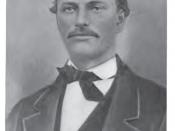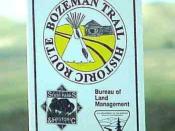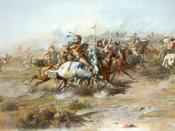RUNNING HEAD: INDIANS
1
INDIANS
Donna Rose
History204
Tami Depasse
July 14, 2014
2
"Go West Young Man" (Greeley, H. 1865) and West is where we went. Which marked the
beginning of the end of the American Indians way of life. A life that was once peaceful and
prosperous for the Sioux Indians was about to change drastically. Throughout history, the Sioux
Indians, had to fight physical and emotional battles, in trying to retain their land and dignity.
Following a time line, the American Indians were treated unjustly, as I will show starting with
the Bozeman Trail and continuing on with The Great Sioux Reservation, Custer's expedition,
Battle of the Little Big Horn, Ghost Dancers, Wounded Knee, Citizenship Act of 1924, The
Indian Reorganization Act, and The American Movement(AIM).
The terrains were rough, being brutal and forcibly tough, especially for the new settlers who
came west, when there was talk of gold.
John Jacobs and his partner John M. Bozeman
established in 1863 a trail that went through Wyoming and Montana that connected
the Oregon Trail. The Bozeman trail was much shorter and more direct, even though, it was
a much better wagon road, however it had its flaws. It just happened to pass through the Lakota
and Cheyenne's hunting grounds. The Indians had warned the first wagon train against
crossing. While some did turn back, Bozeman and others continued on. Over the course of the
next couple of years, nearly two thousand more people traveled the trail, despite Indian attacks.
Something, had to be done. In the spring of 1866. The Lakota and other were invited to Fort
Laramie to try and negotiate a treaty. However during the negotiating, Colonel Henry Carrington
arrived with seven hundred men ready to construct three new forts along the Bozeman Trail.
This action angered the Lakota chief Red Cloud causing a confrontation between the whites and
the Indians. Later that year, Captain William Judd Fetterman joined Carrington's command.
Being a Civil War hero, Fetterman boasted by saying, "With eighty men I could ride through the
3
Sioux nation." On December21, 1866, a wood cutting party, from Fort Kearney had been
attacked, true to his beliefs Fetterman marched out to its aid with a mixed force of eighty infantry
and cavalry soldiers. While Indian decoys drew the soldiers led by Captain
Fettermen over Lodge Trail Ridge and into a trap that had been laid by Red Cloud. All of
Fettermen's command fell to the onslaught. The Lakota's referred to it as "The Battle of a
Hundred Dead". McCaig, D.(2000).Shortly after the Army abandoned the isolated forts, their
Indian allies, the Crow, also left. Early the next morning, as the sun was rising, Red Cloud and
his warriors burned C.F. Smith. A few days later, they went on to burn Fort Phil Kearny.
It was only after the government had abandoned the forts on the Bozeman Trail, that the Treaty
of Laramie was signed. The Treaty set aside land for a reservation for the Lakota Indians that
included all of which is now South Dakota west of the Missouri River. Lakota Chief Red Cloud
also wanted the Bozeman Trail closed. The Union Pacific railroad, could replace the Bozeman
Trail. After completion in 1868, General Ulysses sent word that the U.S, would no longer
defend the Trail. The peace commission arrived by train in Cheyenne, April of 1868
and then traveled the road to Fort Laramie. The new Treaty also allowed the Lakota to
keep hunting on unseeded Indian Territory. In April and May many Indians signed the
Treaty, however Red Cloud did not he was going fall hunt for buffalo, as he did every fall.
In November of 1868, he reluctantly made his mark on the Treaty paper.
Two years later, Red Cloud, along with a party of 20 Lakota traveled by train to Washington
D.C.to meet with President Grant and the Secretary of Interior. After being shown a gun that
Could fire shells weighing hundreds of pounds four miles, Red Cloud didn't think it would be
Much use against Lakota warriors. But being a realist about white powder, Red Cloud, had this
to say "Now we are melting like snow on the hillside, while you are growing like spring grass."
(McCaig. D.2000). the next evening, while giving a speech at Cooper Union, through a
Interpreter he had this to say, even though whites were clothed and ate tame meat and the Indians
Were naked and ate wild meat, the Great Spirit wanted them to live in peace. Six years later
George A. Custer, would realize on Little Bighorn, this, too, was wishful thinking. Red Cloud,
4
himself never went to war again.
Lieutenant Colonel George Armstrong Custer, headed companies of the 7th Cavalry along
with two companies of infantry headed out on July, 1874, there mission was to explore the
uncharted terrain of the Black Hills. Even though Custer and his men, claimed to be in search
of military routes, through the sacred land of the Sioux's, rumor had it, that the expedition
had more to do with gold. The Sioux or Lakota's thought of this area as sacred, and called it
Paha Sapa, meaning picturesque, with pine covered hills. (Patrick 2003). Once it got out that
Had indeed been discovered, Prospectors flooded the area. Gold. The United States was in the
middle of a severe depression, and the gold discovery was one way of getting the economy back
on track. The government offered to buy the region from the Sioux but the Indians refused to sell
and turned down the government's six million dollar offer. At the battle of Little Bighorn on
June, 1876 tensions came to a head.
The Battle of little Bighorn. Occurred in 1876, and is commonly known as "Custer's Last
Stand" (Houlton, Miffin, 1876).On the 25th and 26th of June1876, non-treaty bands of Teton
Sioux (Lakota) and Cheyenne's defended their summer hunting encampment against the U.S.
army, Lieutenant Colonel George Armstrong Custard commanded the attacking forces, while
the principle Indian leaders included Sitting Bull, Crazy House, Hump, and Two Moon. The
battle was the greatest defeat inflicted on the U.S. army in the Plains Wars(2014). Following the
discovery of golden 1874,white miners had been allowed to encroach on this area, which was
sacred to the Sioux and had been granted to them in perpetuity by the U,S government as a
homeland in the Fort Laramie Treaty of 1868. Despite reports of an overwhelming Plain's
Indian force, Custer attacked a Sioux camp, and led a detachment of his 7th Cavalry into
a ravine, where thousands of Indian warriors lay in wait. Custer and his immediate command
a estimated 225 soldiers, were killed. After the battle of Little Bighorn, the Indians were
relentlessly pursued by the army, and by the winter of 1876, most had surround or escaped into
5
Canada. One of the next battles, though not fought on the battlefield, was obtaining citizenship
For the American Indians. This battle was to be fought in court.
In the first half of the nineteenth century, the U.S. government treated Indians who lived in
tribes as members of separate nations. This was to change in the latter half of that century.
Indians were looked at as "wards" or "dependents", (Filiaci, A, M. 2004), neither citizens of the
United States or their own sovereign nation. The Fourteenth Amendment, granted citizenship
to African Americans, but it did not apply to Indians living in tribes. In 1871, congress
stated that "hereafter no Indian nation or tribe within the territory of the United States
shall be ⦠recognized as an intendment nation. "(Filiaci, A.M. 2004). In 1884, the
Supreme Court decided in (Elk vs Wilkins, 1884) that if American Indians adopted the
lifestyle of "European Americans" and did not live with their tribes they could apply
to become citizens and gain the right to vote. The General Allotment Act (also known as the
Dawes Act) was passed in 1887, allowing American Indians citizenship if they agreed to
live "separate and apart from any tribe of Indians." They also had to follow "the habits of
civilized life." (Filiaci, A.M. 2004.) The Dawes Act divided up vast tracts of American
Indian property, giving members of most tribes up to one hundred and sixty acres of land
each. Indians who accepted this tract of land were allowed to become U.S. citizens.
CGEROKEE, CREEK, CHOCTAW, CHICKASAW, SEMINOLE, and OSAGE, were
Excluded from the Dawes Act because these tribes had special treaties with the U.S.
Government. Between 1887 and 1934, the federal government took sixty percent of their
land. After passage of the Dawes Act, policy towards the Indians stressed assimilation;
that is ,the merging of Indians into U.S. society through citizenship, education, and land
ownership. It was not until 1924, that the American Indians became U.S citizens without
conditions, thanks to the Indian Citizenship Act. Despite all the struggles for U.S citizenship
the Iroquois preferred to be a sovereign nation. Many western states did not recognize the
Indian Citizenship Act and did not allow Indians to vote until decades later.
6
In 1890, on Standing Rock Reservation, Chief Sitting Bull was murdered, in an attempt by
reservation police to arrest Sitting Bull the famous Sioux chief, who they mistakenly believed
was a Ghost Dancer. This increased the tension at Pine Ridge. After this, Big Foot and his
Minnecorjou band seeked refuge in Pine Ridge under Red Cloud. Over two hundred and fifty
members of the Big Foot band are massacred by the Seventh Calvary on December 29th
at Wounded Knee. According to historians, Big Foots band of Indians were surrounded by
heavily armed troops and its doubtful they would have intentionally started a fight .
It is believed that the soldiers of the Seventh Calvary were taking revenge for their
defeat at Little Big Horn in 1876.This massacre ended the Ghost Dance movment,
and was the last major conflict between the U.S. Army and the great Sioux Nation.
However, conflict came to Wounded Knee again in February, 1973, when the American
Indian Movement (AIM), staged a seventy one day armed rebellion against the
Federal Government. The village of Wounded Knee, located on the Pine Ridge Reservation in
South Dakota was the scene of the rebellion in the early months of 1973. The 1973 incident led
by AIM activist Russell Means, drew international attention, exposing the tension between
American Indians and the Federal Government as well as rifts among Indian people themselves.
On February, 1973, between 200 and three hundred Indian activists, mostly armed with deer
hunting rifles seized Wounded Knee to protest poor living condition and the perceived
corruption of reservation officials,. The protesters proceeded to visit and pray over the mass
grave of the1890 Wounded Knee massacre (Chapman,2010). Others raided the reservations
trading post and museum, destroying artifacts. AIM members believed that the Wounded Knee
tribal chairman, and his supporting Sioux council represented a illegitimate puppet reign, which
they referred to as (White Wounded Knee).The AIM leaders presented three demands to the U,S.
government. Restore and honor 371 broken treaties: Reform the Bureau of Indian Affairs and
conduct an investigation of the corruption at Wounded Knee. The ultimate goal of AIM was to
secure self-government for Native Americans. During the standoff, AIM declared the
7
independence of the Oglala Sioux Nation and specified its boundaries were in accordance with
rhe Treaty of Laramie(1868.).
The senior U.S. Governor of South Dakota, Democrat George McGovern, who had just been
defeated in the 1972 Presidential Election, arrived at the scene. He was remembered for having
stated," that past wrongs against Native Americans should be forgotten".(1973). (It is ridiculous
to talk about treaties abrogated by an act if Congress over 100 years ago ).President Richard
Nixon chose to deploy hundreds of FBI and U.S. Marshals service agents. Nixon, aware of
public perception with the activist, sought to resolve the situation peacefully. Despite these
intentions, two AIM members were killed and the federal agents carried out a series of military
operation thought to exhaust the occupiers. On May 8th, 1973, the protesters finally surrendered
accomplishing very little.
In June 1934, a measure was enacted by congress, aimed at decreasing federal control of
Indian affairs and increasing self-government and responsibility. This was called the Indian
Reorganization Act, also called The Wheeler- Howard Act (June, 1934). This was in thanks
for the Indians service to America in World War 1. In 1924, Congress authorized the Meriam
Survey to establish the condition of life on the reservations. Details, in the Meriam Report of
1928, reported the shocking conditions and spurred demands for reform. Many of the
recommendations in the Meriam report were incorporated in the Indian Reorganization Act.
The act stopped the future allotment of tribal lands to individuals and provided for the return
Of surplus lands to the tribes instead of the homesteaders. Constitutions and charters, given
Indians the power to manage their internal affairs was encouraged. Funds were made available
For a revolving credit program to purchase land and assist in educational programs. Many tribes
adopted written constitutions and improved their economic position through the revolving credit
fund. With the funds for land purchase, millions of additional acres were added to the
8
reservations. By 1950 half of all Indian children were enrolled in public school and had much
improved health and education.
With the Civil Rights Movement in full force, an Indian movement began to take shape
during the late1950's and early 1960's. This movement coincided with the beginning of
the first generation of Native American scholars who wrote and spoke of their people's
plight. In March 1964 a group of Sioux, began a four hour (occupation) at Alcatraz Island in San
Francisco Bay, claiming the land as Indian territory and demanding that it be made into a Indian
university and cultural center. The long standing reliance of Native Americans on the Federal
Government began to change in 1934. For the next twenty years the government minimized
its role on reservations. This culminated in President Dwight D. Eisenhower's attempt
to stop the funding completely. Eisenhower wanted the relocation of large numbers of
Indians to American cities where they could get their own education and become self-stuffiest
While Native Americans were being removed from their homes and separated from their
families, tribal leaders began to speak out. Numerous tribes met across the United States
between 1958 and 1967 to discuss their complaints, resulting in the founding of AIM
(American Indian Movement), In November, 1969, activist Richard Oaks led a group of
Indian students and urban Indians in a second takeover of Alcatraz Island in San Francisco Bay.
This occupation lasted nineteen months with Indians from many tribes moving onto the island
to create a public awareness of their goals. They also wanted the deed to the island so they could
go ahead with their plans for a university and cultural center. This protest brought national
attention to Indian grievances but did not directly involve AIM. President Richard Nixon, would
not negotiate but refused to take the island by force, afraid that the news media would side with
the Indians. Instead, he cut off electrical power, and removed the islands fresh water supply.
These conditions caused tension among the Indian leadership. In early 1971, three of the
9
protesters were convicted of selling copper tubing stripped from buildings on the island. When
the media turned against the occupiers, only then did Nixon plan for a forced removal. This was
carried out on June 10th,1971 without incident. It ended with Native Americans gaining the
national attention.( Laird,G.2010)
In conclusion, I have taken you on a eventful ride, there have been great loses on both sides,
From the massacre at Wounded Knee, to Custer's last stand. The greed of gold, and the
Prosperity the settler's seeked, to the Sioux's wanting to preserve their land. In the end,
And through the smudged lens of time it is easy to deplore and admire both
peoples. (McCaig, D.2000).
10
Reference
Chapman, R. (2010). Wounded knee incident. In Culture wars: An encyclopedia of issues, viewpoints, and voices. Retrieved from http://search.credoreference.com.proxy-library.ashford.edu/content/entry/sharpeew/wounded_knee_incident/0
Filiaci, A. M. (2004). ANATIVE AMERICAN. Cobblestone, 25(3), 26. Retrieved from http://search.ebscohost.com/login.aspx?direct=truedb=15h&AN=12481664&site=eds-live"site=eds-live
Laird, G.(2010). American indian movement. In Culture wars: An encyclopedia of issue,
Viewpoints, and voices. 1924 Retrieved from
http://search.credoreference.com/content/entry.sharpecw/american_indian_movement/0
Little bighorn, battle of the, (1966). In Encyclopedia of north American Indians, Houghton Miffin.
Retrieved from: http://search.credoreference.com/content/entry/hmenai/little_bighorn_battle_of_the/0
Little bighorn, battle of the. (2014). In the Hutchinson unabridged encyclopedia with atlas and weather guide Retrieved from: http://search.credoreference.comcontent/entry/heliconhe/little_bighorn_battle_of_the/0
McCaig, D. (2000). THE Bozeman Trail. Smithsonian, 31(7), 88.
Retrieved fhttp://search.ebscohost.com/login.aspx?direct=true HYPERLINK "http://search.ebscohost.com/login.aspx?direct=true&db=f5h&AN=3583976&site=eds-live"& H
Patrick, W.C. (2003). Custer's Black Hills Expedition. (cover Story).American History, 38(2), 34. Retrieved from:http://search.ebscohost.com/login.aspx?direct=true HYPERLINK "http://search.ebscohost.com/login.aspx?direct=true&db=f5h&AN=9901598&site=eds-live"& H
Treaty with the Sioux-Brule, Oglala, Miniconjou, Yanktonai, Hunkpapa, Blackfeet, Cuthead, Two Kettle, San Arcs, and Santee-and Arapaho, 4/29/1868; General Records of the United States Government; Record Group 11; National Archives.
http://www.ourdocuments.gov/doc.php?flash=true HYPERLINK "http://www.ourdocuments.gov/doc.php?flash=true&doc=42"& HYPERLINK "http://www.ourdocuments.gov/doc.php?flash=true&doc=42" doc=42
Powers, T .(2010). HOW LITTLE BIGHORN WAS WON. Smithsonian, 41(7), 82-106 Retrieved from: http://search.ebscohost.com.proxy-library.ashford.edu/login.aspx?direct=true HYPERLINK "http://search.ebscohost.com.proxy-library.ashford.edu/login.aspx?direct=true&AuthType=ip,cpid&custid=s8856897&db=a9h&AN
Young, Steve.(2013). A Long Way To Go' in South Dakota Race Relation Retrieved from:
http://archive.argusleader.com/article/20131007/NEWS/310070018/-long-ways-go-South-Dakota-race-relations
.
7


